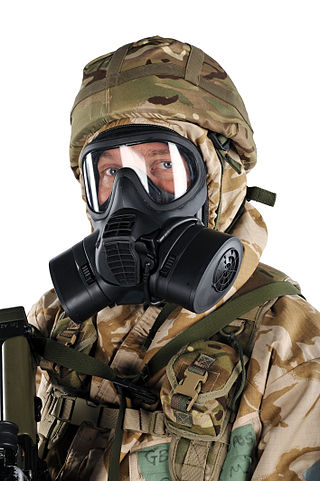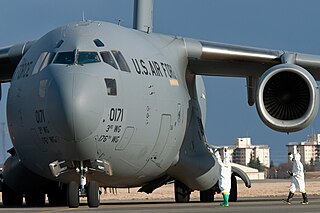
A gas mask is a mask used to protect the wearer from inhaling airborne pollutants and toxic gases. The mask forms a sealed cover over the nose and mouth, but may also cover the eyes and other vulnerable soft tissues of the face. Most gas masks are also respirators, though the word gas mask is often used to refer to military equipment, the scope used in this article. The gas mask only protects the user from digesting, inhaling, and contact through the eyes. Most combined gas mask filters will last around 8 hours in a biological or chemical situation. Filters against specific chemical agents can last up to 20 hours.

Personal protective equipment (PPE) is protective clothing, helmets, goggles, or other garments or equipment designed to protect the wearer's body from injury or infection. The hazards addressed by protective equipment include physical, electrical, heat, chemicals, biohazards, and airborne particulate matter. Protective equipment may be worn for job-related occupational safety and health purposes, as well as for sports and other recreational activities. Protective clothing is applied to traditional categories of clothing, and protective gear applies to items such as pads, guards, shields, or masks, and others. PPE suits can be similar in appearance to a cleanroom suit.
Radiation protection, also known as radiological protection, is defined by the International Atomic Energy Agency (IAEA) as "The protection of people from harmful effects of exposure to ionizing radiation, and the means for achieving this". Exposure can be from a source of radiation external to the human body or due to internal irradiation caused by the ingestion of radioactive contamination.

Chemical, biological, radiological and nuclear defense or NBC protection are protective measures taken in situations in which chemical, biological, radiological or nuclear hazards may be present. CBRN defence consists of CBRN passive protection, contamination avoidance, and weapons of mass destruction mitigation.

A respirator is a device designed to protect the wearer from inhaling hazardous atmospheres including fumes, vapours, gases and particulate matter such as dusts and airborne pathogens such as viruses. There are two main categories of respirators: the air-purifying respirator, in which respirable air is obtained by filtering a contaminated atmosphere, and the air-supplied respirator, in which an alternate supply of breathable air is delivered. Within each category, different techniques are employed to reduce or eliminate noxious airborne contaminants.

A hazmat suit is a piece of personal protective equipment that consists of an impermeable whole-body garment worn as protection against hazardous materials. Such suits are often combined with self-contained breathing apparatus (SCBA) to ensure a supply of breathable air. Hazmat suits are used by firefighters, emergency medical technicians, paramedics, researchers, personnel responding to toxic spills, specialists cleaning up contaminated facilities, and workers in toxic environments.

MOPP is protective gear used by U.S. military personnel in a toxic environment, e.g., during a chemical, biological, radiological, or nuclear (CBRN) strike:

ILC Dover, LP is a special engineering development and manufacturing company, globally headquartered in Newark, Delaware. ILC Dover specializes in the use of high-performance flexible materials, serving the aerospace, personal protection, and pharmaceutical industries.

The Defence Chemical, Biological, Radiological and Nuclear Centre is a United Kingdom military facility at Winterbourne Gunner in Wiltshire, south of Porton Down and about 4 miles (6 km) northeast of Salisbury. It is a tri-service location, with the Army being the lead service. The centre is responsible for all training issues relating to chemical, biological, radiological and nuclear (CBRN) defence and warfare for the UK's armed forces.

The 20th CBRNE Command is the United States Army's Chemical, Biological, Nuclear, Radiological and high-yield explosives headquarters.

The use of personal protective equipment (PPE) is inherent in the theory of universal precaution, which requires specialized clothing or equipment for the protection of individuals from hazard. The term is defined by the Occupational Safety and Health Administration (OSHA), which is responsible for PPE regulation, as the "equipment that protects employees from serious injury or illness resulting from contact with chemical, radiological, physical, electrical, mechanical, or other hazards." While there are common forms of PPEs such as gloves, eye shields, and respirators, the standard set in the OSHA definition indicates a wide coverage. This means that PPE involves a sizable range of equipment. There are several ways to classify them such as how gears could be physiological or environmental. The following list, however, sorts personal protective equipment according to function and body area.
Operations Plus WMD is a training level in dealing with hazardous materials.

The General Service Respirator (GSR) is a military gas mask designed to replace the previous S10 respirator for the British Armed Forces. It was designed by the Defence Science and Technology Laboratory and Scott Safety in collaboration with the Ministry of Defence, and was manufactured by Scott Safety. Avon Protection now manufactures the GSR from its factory in Melksham after winning the in-service support contract in 2019.

Escape respirators are a portable breathing apparatus or mask that regenerates breathable air to help provide respiratory protection for emergency escape from areas containing harmful gases or IDLH atmospheres. There are two types of escape respirators: air-purifying escape respirators and self-contained escape respirators. Often times, these respirators utilize an easy-to-put-on hood and some sort of supplied air tank or filter attachment that cleans the incoming air for the user. Escape respirators are not to be used for anything other than escaping a contaminated environment. Escape respirators are not to be used for general or everyday respiratory protection. A cross-breed between a gas mask and a respirator, the escape respirator is used extensively in the mining and chemical industries, and by emergency responders. Escape respirators should be certified by a national authority analogous to the United States' National Institute for Occupational Safety and Health for escaping from the atmosphere in which the respirator is manufactured for.

The Emergency Management (EM) career field is the United States Air Force's (USAF) primary organization responsible for implementing an installation-level EM program. Emergency Managers, also known by the Air Force Specialty Code (AFSC) 3E9X1, are the Air Force's subject matter experts for all non-medical Chemical, Biological, Radiological and Nuclear (CBRN) passive defense and consequence management matters.
During wartime operations, 3E9X1s are assigned to CBRN reconnaissance teams responsible for detecting, identifying, quantifying, and collecting CBRN material ensuring mission continuation and force survivability.
An overpressure protection system is one designed to protect an individual or group of individuals in a chemical, biological, radiological and nuclear (CBRN) environment. The two parts of the system are a safe area which as far as possible is sealed from possible contaminated air and an air filtration system which will filter out all possible toxins. Air pumps force clean air through the filters into the safe area such that the air pressure within the safe area will always be higher than that outside of the safe area. This pressure differential means that any flows of air will always be from the safe area to the outside, preventing the ingress of toxins.

The Nuclear, Biological and Chemical Protection Troops of the Russian Armed Forces are an organisation designed to reduce the losses of the Ground Forces and ensuring their combat tasks assigned during operations in conditions of radioactive, chemical and biological contamination, as well as at enhancing their survivability and protection against high-precision and other weapons.

Joint Service Lightweight Integrated Suit Technology (JSLIST), also known as Advanced Chemical Protective Garment (ACPG) by the U.S. Navy, is a suit used by the U.S. Military for protection against CBRN hazards. It is part of the MOPP ensemble. The JSLIST is made to be worn over the Battle Dress Uniform. The suit consists of lightweight chemical and biological protective clothing consisting of a two piece suit, overboots, gloves, and respiratory equipment. The suit is air permeable to allow breathing to help with the user's comfort and reduce heat stress. The JSLIST has a 120-day service life when removed from packaging, can be worn for 45 consecutive days in an uncontaminated environment, and can be cleaned up to 6 times.

















